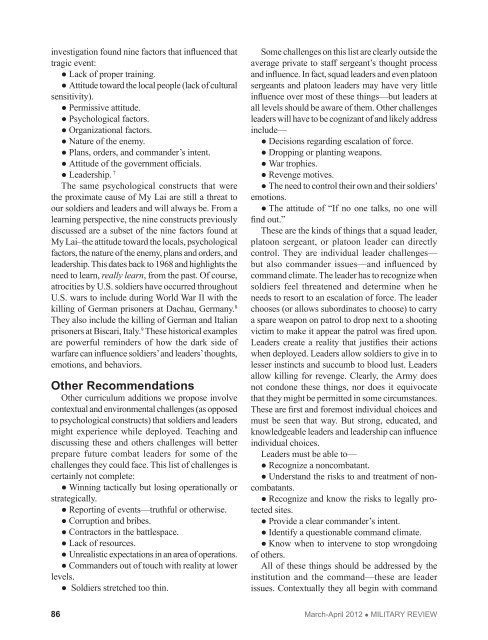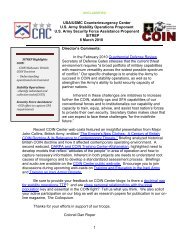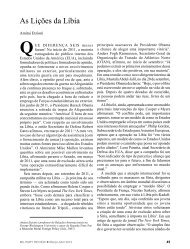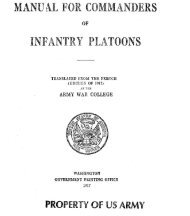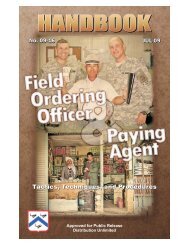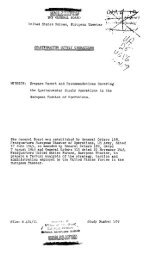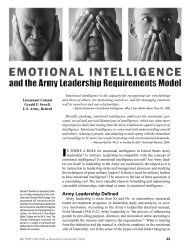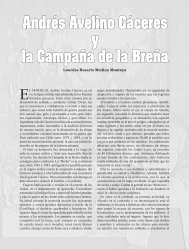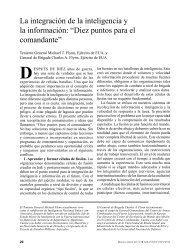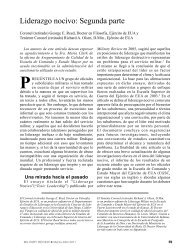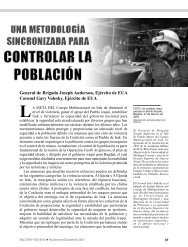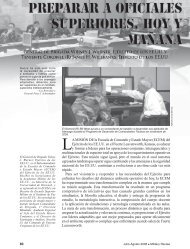Joe Doty - US Army Combined Arms Center and Fort Leavenworth
Joe Doty - US Army Combined Arms Center and Fort Leavenworth
Joe Doty - US Army Combined Arms Center and Fort Leavenworth
Create successful ePaper yourself
Turn your PDF publications into a flip-book with our unique Google optimized e-Paper software.
investigation found nine factors that influenced that<br />
tragic event:<br />
● Lack of proper training.<br />
● Attitude toward the local people (lack of cultural<br />
sensitivity).<br />
● Permissive attitude.<br />
● Psychological factors.<br />
● Organizational factors.<br />
● Nature of the enemy.<br />
● Plans, orders, <strong>and</strong> comm<strong>and</strong>er’s intent.<br />
● Attitude of the government officials.<br />
● Leadership. 7<br />
The same psychological constructs that were<br />
the proximate cause of My Lai are still a threat to<br />
our soldiers <strong>and</strong> leaders <strong>and</strong> will always be. From a<br />
learning perspective, the nine constructs previously<br />
discussed are a subset of the nine factors found at<br />
My Lai–the attitude toward the locals, psychological<br />
factors, the nature of the enemy, plans <strong>and</strong> orders, <strong>and</strong><br />
leadership. This dates back to 1968 <strong>and</strong> highlights the<br />
need to learn, really learn, from the past. Of course,<br />
atrocities by U.S. soldiers have occurred throughout<br />
U.S. wars to include during World War II with the<br />
killing of German prisoners at Dachau, Germany. 8<br />
They also include the killing of German <strong>and</strong> Italian<br />
prisoners at Biscari, Italy. 9 These historical examples<br />
are powerful reminders of how the dark side of<br />
warfare can influence soldiers’ <strong>and</strong> leaders’ thoughts,<br />
emotions, <strong>and</strong> behaviors.<br />
Other Recommendations<br />
Other curriculum additions we propose involve<br />
contextual <strong>and</strong> environmental challenges (as opposed<br />
to psychological constructs) that soldiers <strong>and</strong> leaders<br />
might experience while deployed. Teaching <strong>and</strong><br />
discussing these <strong>and</strong> others challenges will better<br />
prepare future combat leaders for some of the<br />
challenges they could face. This list of challenges is<br />
certainly not complete:<br />
● Winning tactically but losing operationally or<br />
strategically.<br />
● Reporting of events—truthful or otherwise.<br />
● Corruption <strong>and</strong> bribes.<br />
● Contractors in the battlespace.<br />
● Lack of resources.<br />
● Unrealistic expectations in an area of operations.<br />
● Comm<strong>and</strong>ers out of touch with reality at lower<br />
levels.<br />
● Soldiers stretched too thin.<br />
Some challenges on this list are clearly outside the<br />
average private to staff sergeant’s thought process<br />
<strong>and</strong> influence. In fact, squad leaders <strong>and</strong> even platoon<br />
sergeants <strong>and</strong> platoon leaders may have very little<br />
influence over most of these things—but leaders at<br />
all levels should be aware of them. Other challenges<br />
leaders will have to be cognizant of <strong>and</strong> likely address<br />
include—<br />
● Decisions regarding escalation of force.<br />
● Dropping or planting weapons.<br />
● War trophies.<br />
● Revenge motives.<br />
● The need to control their own <strong>and</strong> their soldiers’<br />
emotions.<br />
● The attitude of “If no one talks, no one will<br />
find out.”<br />
These are the kinds of things that a squad leader,<br />
platoon sergeant, or platoon leader can directly<br />
control. They are individual leader challenges—<br />
but also comm<strong>and</strong>er issues—<strong>and</strong> influenced by<br />
comm<strong>and</strong> climate. The leader has to recognize when<br />
soldiers feel threatened <strong>and</strong> determine when he<br />
needs to resort to an escalation of force. The leader<br />
chooses (or allows subordinates to choose) to carry<br />
a spare weapon on patrol to drop next to a shooting<br />
victim to make it appear the patrol was fired upon.<br />
Leaders create a reality that justifies their actions<br />
when deployed. Leaders allow soldiers to give in to<br />
lesser instincts <strong>and</strong> succumb to blood lust. Leaders<br />
allow killing for revenge. Clearly, the <strong>Army</strong> does<br />
not condone these things, nor does it equivocate<br />
that they might be permitted in some circumstances.<br />
These are first <strong>and</strong> foremost individual choices <strong>and</strong><br />
must be seen that way. But strong, educated, <strong>and</strong><br />
knowledgeable leaders <strong>and</strong> leadership can influence<br />
individual choices.<br />
Leaders must be able to—<br />
● Recognize a noncombatant.<br />
● Underst<strong>and</strong> the risks to <strong>and</strong> treatment of noncombatants.<br />
● Recognize <strong>and</strong> know the risks to legally protected<br />
sites.<br />
● Provide a clear comm<strong>and</strong>er’s intent.<br />
● Identify a questionable comm<strong>and</strong> climate.<br />
● Know when to intervene to stop wrongdoing<br />
of others.<br />
All of these things should be addressed by the<br />
institution <strong>and</strong> the comm<strong>and</strong>—these are leader<br />
issues. Contextually they all begin with comm<strong>and</strong><br />
86 March-April 2012 • MILITARY REVIEW


